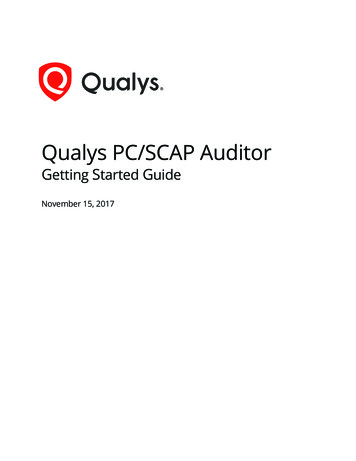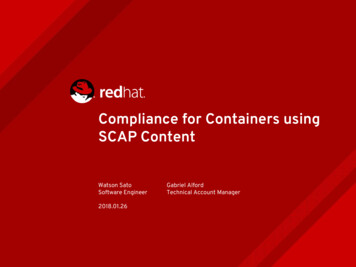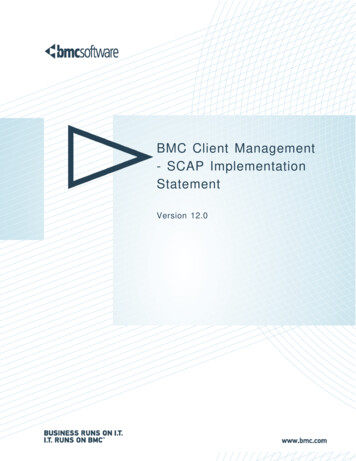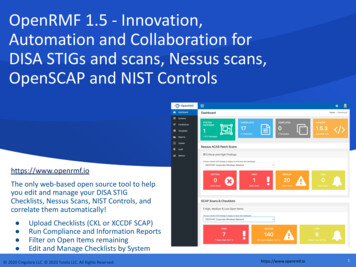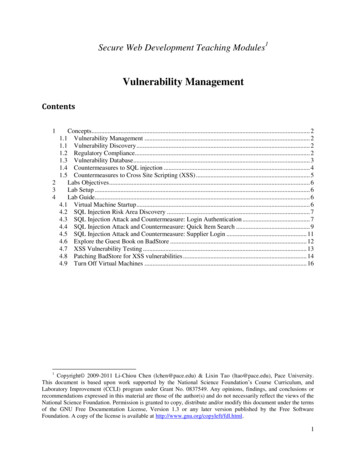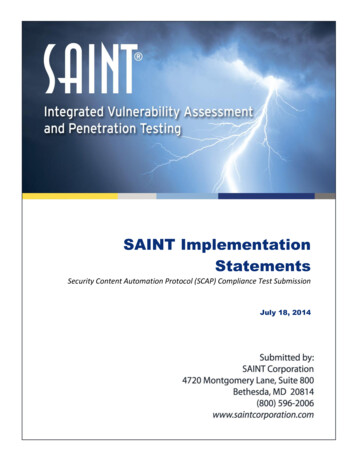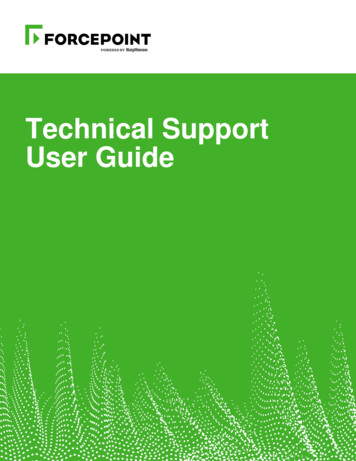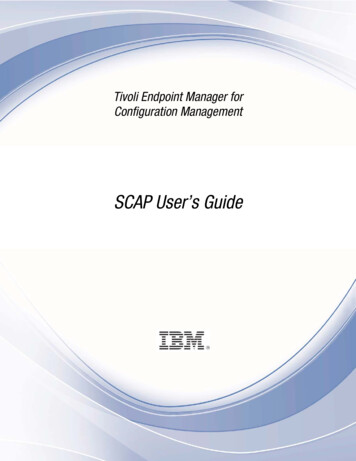
Transcription
Tivoli Endpoint Manager forConfiguration ManagementSCAP User’s GuideUser’s Guidei
Note: Before using this information and the product it supports, read the information in Notices. Copyright IBM Corporation 2003, 2011.US Government Users Restricted Rights – Use, duplication or disclosure restricted by GSA ADPSchedule Contract with IBM Corp.iiConfiguration Management - SCAP
ContentsPart One 1About Configuration Management 1Checklists 1Custom sites 1Part Two 3About SCAP 3Information Security Automation Program 3SCAP overview 3SCAP standards 4Content Availability Options 6SCAP Fixlet Checklists 6SCAP Generation Wizards 7Part Three 9Using SCAP 9Subscribing to SCAP content 9Using the SCAP Import Wizard 10Using the SCAP Report Creation Wizard 11Part Four 15Resources 15Frequently asked questions 15Glossary 16Abbreviations 17Technical support 17Part Five 19Notices 19User’s Guideiii
ivConfiguration Management - SCAP
Part OneAbout Configuration ManagementTivoli Endpoint Manager Configuration Management is a portfolio of content in the form ofchecklists that allow organizations to assess and manage the configurations of desktops, laptops,and servers. Tivoli Endpoint Manager Configuration Management is one of the few products tohave achieved Security Content Automation Protocol (SCAP) through the National Institute ofStandards and Technology (NIST) for both misconfiguration assessment and remediation. Byoffering a comprehensive library of technical controls, Configuration Management detects andenforces security configuration policies using industry best practices.ChecklistsConfiguration Management checklists assess and manage the configurations of desktops,laptops, and servers. Security teams use the Configuration Management checklists to define andassess security parameters and configurations that are required by organizational policy. ITmanagers use the Configuration Management checklists to enforce security policy and documentthe current state of compliance with documented policy. Auditors use them to determine thecurrent state of compliance for any given set of systems within the entire organization.For detailed information about how to configure Windows or UNIX checklists, see theConfiguration Management Checklists Guide.Custom sitesYou can control your security status by customizing Configuration Management and excludingspecific computers from an analysis. You can also create custom sites and repurpose theConfiguration Management checklists to fine-tune your deployment.Creating a custom siteTo create a custom checklist based on one or more subscribed external checklists, use theCreate Custom Checklist wizard located in the “Checklist Tools” folder in the console SecurityConfiguration domain. For more information about using this wizard, see the ConfigurationManagement Checklists Guide.Subscribing clients to the custom siteAfter creating your custom site, you must subscribe computers to it. The correct collection ofcompliance data depends on targeting the content to the appropriate computers. You cansubscribe computers to your site by specific computers or by computer properties. For detailedinformation about how to create and manage custom sites, see the Configuration ManagementUser’s Guide.User’s Guide1
2Configuration Management - SCAP
Part TwoAbout SCAPThe ability to automate technical configurations on devices across enterprise infrastructures hasbeen a historical challenge. Organizations such as the National Institute of Standards andTechnology (NIST), National Security Agency (NSA), the Center for Internet Security (CIS), andthe Defense Information Systems Agency (DISA) have attempted to provide guidance throughdocumentation, standards, and guidelines. But technology has limited the ability for fullautomation of these technical configurations, especially at scale across globally distributedenvironments.The Security Content Automation Protocol (SCAP) has been adopted to meet this challenge. Aspart of the Configuration Management product, SCAP is a method for automating the definition,consumption, and assessment of system configurations on desktop systems throughout anorganization’s infrastructure. IBM Tivoli Endpoint Manager provides real-time visibility andcontrol over system configurations through a single infrastructure, single agent, and singleconsole, and enables continuous assessment and enforcement of SCAP configuration baselinesfor on- and off-network systems. With Tivoli Endpoint Manager, federal agencies can easilyidentify systems that are not compliant to a SCAP data stream, remediate settings found to benon-compliant, and report on the configuration status of one or more systems in real-time.Information Security Automation ProgramThe Information Security Automation Program (ISAP) automates and standardizes technicalsecurity operations. Primarily focused on government, ISAP offers security checking, remediation,and automation of technical compliance activities to such regulations as FISMA and the FDCC.ISAP objectives include enabling standards-based communication of vulnerability data,customizing and managing configuration baselines for various IT products, assessing informationsystems and reporting compliance status, using standard metrics to weight and aggregatepotential vulnerability impact, and remediating identified vulnerabilities.SCAP overviewISAP technical specifications are contained in the related Security Content Automation Protocol(SCAP). SCAP consists of a suite of standards that enable automated vulnerability management,measurement, and policy compliance evaluation, for example, FISMA compliance.Specifically, SCAP standards address the following objectives: Enumerate software flaws, security-related configuration issues, and product names Measure systems to determine the presence of vulnerabilities Provide mechanisms to rank the results of these measurements to evaluate the impact ofthe discovered security issuesUser’s Guide3
SCAP defines how these standards are combined. The U.S. National Institute of Standards andTechnology (NIST) maintains the National Checklist Program (NCP) and provides a repository ofdata feeds that use the SCAP standards. It is also the repository for official SCAP standards data.NIST defines and maintains the protocol and the data feeds of content in the SCAP standards.Thus, NIST defines how to use the open standards within the SCAP context and defines themappings between the SCAP enumeration standards.SCAP standardsSCAP is comprised of the following standards:Common Vulnerabilities and Exposures (CVE )The SCAP CVE standard is a dictionary of publicly known information security vulnerabilities thatenable data exchanges between security products and provide a baseline index point forevaluating coverage of tools and services.Tivoli Endpoint Manager has actively supported CVE for several versions of the product andmaintains a mature product integration with CVE content. Any security patch or vulnerability thathas an associated CVE ID and is available as either a SCAP data stream or available throughother Tivoli Endpoint Manager developed processes will display the relevant CVE ID within theTivoli Endpoint Manager console.You can find this ID associated with a given security patch or vulnerability by opening the TivoliEndpoint Manager console and navigating to a patch or vulnerability Fixlet site, double-clicking arelevant Fixlet, selecting the Details tab and viewing the CVE ID. The CVE ID is also accessiblefrom other views and can be used as part of the reporting criteria for detailed and summaryreports on individual end-point systems or for a large group of systems reported on in theaggregate.Common Configuration Enumeration (CCE )The SCAP CCE standard provides unique identifiers to system configuration issues to facilitatefast and accurate correlation of configuration data across multiple information sources and tools.For example, CCE Identifiers can associate checks in configuration assessment tools withstatements in configuration best practice documents. The Tivoli Endpoint Manager platformincludes the ability to assess workstations, laptops, servers, and mobile computing devicesagainst common configuration settings to identify misconfiguration states in a diverse computingenvironment. Tivoli Endpoint Manager fully supports CCE and displays the CCE ID for eachmisconfiguration for which there is a CCE ID within the Tivoli Endpoint Manager console. In thecase where a misconfiguration is associated with multiple CCE IDs, all IDs are cross-referencedand displayed.To find the CCE ID associated with a configuration setting, open the Tivoli Endpoint Managerconsole and navigate to a configuration setting used by a SCAP data stream. Click on a Fixletthat represents a configuration setting and view the Source ID column. The Source ID displays4Configuration Management - SCAP
the CCE ID. The CCE ID is also accessible from other views and can be used as part of thereporting criteria for detailed reports and summary reports on individual end-point systems or fora large group of systems reported on in the aggregate.Common Platform Enumeration (CPE )The SCAP CPE standard is a structured naming scheme for information technology systems,platforms, and packages. Based on the generic syntax for Uniform Resource Identifiers (URI),CPE includes a formal name format, a language for describing complex platforms, a method forchecking names against a system, and a description format for binding text and tests to a name.Tivoli Endpoint Manager uses CPE to ensure that configuration settings are assessed on thecorrect system. Regardless of the operating system, the CPE ID can identify a platform andensure that an assessment is performed.You can assess and remediate system configurations by targeting systems by platform in additionto other targeting mechanisms. By targeting a particular platform, you can ensure that systemscans are done properly and are weighed against applicable configuration checks. Checks areassessed in real-time based on the platform and policies can be enforced, giving administratorscurrent visibility and control over platforms in a distributed or non-distributed computingenvironment.Common Vulnerability Scoring System (CVSS)The SCAP CVSS standard provides an open framework for communicating the characteristics ofIT vulnerabilities. Its quantitative model ensures repeatable, accurate measurement whiledisplaying vulnerability characteristics used to generate the scores. Thus, CVSS is well suited asa standard measurement system for industries, organizations, and agencies that need accurateand consistent vulnerability impact scores.Tivoli Endpoint Manager assesses and reports on vulnerabilities and quantifies the impact formultiple computing platforms. Tivoli Endpoint Manager fully supports the CVSS standard anddisplays both the CVSS base score for each applicable vulnerability and the CVSS Base ScoreVector used to produce the score.Tivoli Endpoint Manager administrators can access the CVSS score and the associated vectorstring from within the Tivoli Endpoint Manager console. For additional details, administrators cannavigate to the a vulnerability definition from within the Fixlets. Tivoli Endpoint Manager providesa link for administrators to connect to the CVSS definition located on the NVD website. TivoliEndpoint Manager enhances the value of CVSS by displaying this common metric for detailedreports on individual end-point systems and for large groups of systems reported on in theaggregate.Extensible Configuration Checklist Description Format (XCCDF)The SCAP XCCDF standard is a specification language for writing security checklists,benchmarks, and related documents. An XCCDF document represents a structured collection ofsecurity configuration rules for some sets of target systems and is the core element of the SCAPdata stream. The specification also defines a data model and format for storing results ofchecklist compliance testing.User’s Guide5
SCAP data streams use the XCCDF format to translate underlying configuration checks that aredefined in Tivoli Endpoint Manager Fixlets. When created, these SCAP-based configurationFixlets allow administrators to assess their computing assets against the SCAP-definedconfiguration rules in real-time and on a global scale.When the SCAP configuration rules are imported into Tivoli Endpoint Manager, any system canimmediately assess against the defined configuration rules. The results of those configurationchecks are relayed to the Tivoli Endpoint Manager console, where administrators can view resultsand generate detailed reports on an individual system or on large groups of systems.Tivoli Endpoint Manager also exports the results of the configuration checks into the definedXCCDF report format so that the organization can store, send, or import those reports intoanother tool.Open Vulnerability and Assessment Language (OVAL )The SCAP OVAL standard is an international, information security community standard thatpromotes security content and standardizes the transfer of this information across an entirespectrum of security tools and services. The OVAL language is a collection of XML schema forrepresenting system information, expressing specific machine states, and reporting the results ofan assessment.Through a repository of vulnerability assessment policies, Tivoli Endpoint Manager assessesmanaged computers against OVAL vulnerability definitions using real-time data tracking based onthe data elements of each definition. These policies are automatically retrieved by the TivoliEndpoint Manager product within an organization's network. When validated for authenticity, thepolicies are made available to the Tivoli Endpoint Manager client installed on each managedcomputer and added to their local library of configuration policies. The agent continuouslyevaluates the state of the machine against each policy so that any instance of non-compliancecan be reported to the Tivoli Endpoint Manager Server for administrator review. If pre-authorizedby an administrator, the appropriate corrective action is applied to the computer immediately uponmisconfiguration detection, even to remote or mobile users not connected to the organization'snetwork.Content Availability OptionsSCAP is comprised of SCAP Fixlet checklists and SCAP generation wizards, which TivoliEndpoint Manager administrators can use to manage and maintain SCAP-based checklistcontent and compliance results.SCAP Fixlet ChecklistsTivoli Endpoint Manager distributes Fixlets through subscription and sites. Tivoli EndpointManager has taken the SCAP checklist XML, generated Tivoli Endpoint Manager content from it,and made it available through subscription. Customers load the external site mastheads for eachof the available SCAP checklists in the Tivoli Endpoint Manager console, and the Tivoli Endpoint6Configuration Management - SCAP
Manager server downloads the content and makes it available to the Tivoli Endpoint Manageradministrator to begin evaluating on systems.Tivoli Endpoint Manager currently provides out-of-the-box content for the Federal Desktop CoreConfiguration (FDCC) SCAP checklists. As new checklists are made available by NIST, TivoliEndpoint Manager might include those sites as part of the subscription service.In addition to the Fixlet sites, Tivoli Endpoint Manager includes a reporting dashboard thatprovides visibility into the results of the system evaluations and a reporting dashboard forgenerating Tivoli Endpoint Manager content from an SCAP checklist. These dashboards arefound in the Configuration Management Reporting site.The following out-of-the-box SCAP checklists are currently available as part of this product: FDCC on Windows XPFDCC on Windows XP FirewallFDCC on Windows VistaFDCC on Windows Vista FirewallFDCC on Internet Explorer 7USGCB on Windows 7 FirewallUSGCB on Windows 7 EnergyUSGCB on Internet Explorer 8USGCB on Windows 7SCAP Generation WizardsYou can customize SCAP checklists to generate your own configuration checklists rather thanusing subscription-based content. To facilitate this, Tivoli Endpoint Manager provides tools thatallow you to use a SCAP checklist and generate Fixlets to assess one or more endpoints.The following tools are included:1. SCAP Import Wizard – This wizard generates Tivoli Endpoint Manager content from a SCAPchecklist. The content is then imported into a custom site that you create for this purpose. Itincludes a Fixlet for each check in the SCAP checklist.User’s Guide7
2. SCAP Report Creation Wizard – This Wizard is used to create an XCCDF results file foreach managed endpoint.8Configuration Management - SCAP
Part ThreeUsing SCAPTivoli Endpoint Manager provides periodic updates in the FDCC content. However, you can alsouse SCAP tools to generate content from other SCAP checklists.Subscribing to SCAP contentThe Tivoli Endpoint Manager Configuration Management solution consists of several externalFixlets that can be imported into the Tivoli Endpoint Manager console to evaluate one or moresystems. Each Fixlet provides a specific set of content based on the translation of an individualSCAP data stream into a set of Fixlets. Each Fixlet represents a single configuration check asdescribed in the SCAP data stream.After the SCAP site is loaded into the console, content is updated and continuously evaluatesendpoints for compliance with the configuration standard.The process for site subscription depends on your version of the Tivoli Endpoint Managerconsole. For specific site subscription directions, see the Tivoli Endpoint Manager KnowledgeBase article here.After the SCAP site is loaded into the console, the Tivoli Endpoint Manager server gathers thecontent and displays it in the Configuration Management navigation tree.Note:User’s GuideWhen Tivoli Endpoint Manager generates Fixlets from a SCAP data stream, theCPE strings associated with the SCAP data stream determine what types ofsystems must evaluate against the content. When subscribed, systemsevaluate the content, if the content matches the defined CPE string. Thisbehavior can be altered. For more information, see the Tivoli Endpoint ManagerSupport website.9
Using the SCAP Import WizardUse this wizard to generate Tivoli Endpoint Manager content from a set of SCAP XML input files.The content that is generated includes a Fixlet for each check found in the SCAP checklist.Before using the wizard, you must create a custom site that will contain the resulting checklist.For more information about using custom checklists, see the Configuration Management User’sGuide.SCAP checklists can be found here. The SCAP Import Wizard has been validated for checklistsat Tier IV in this repository. To use the import wizard, perform the following steps:1. Click Browse and select the XCCDF file to be imported.2. Optional: Check the OVAL content requirements box.3. Optional: Specify an XCCDF XSD schema file that will be used to validate the XML input.4. Click Load Profiles. The window for selecting the XCCDF profiles is displayed. Thisprocess might take from 1 to 2 minutes.5. Select an XCCDF profile from the menu.6. Click Import. The Import Content window is displayed. Select the custom site from themenu and click OK.10Configuration Management - SCAP
Using the SCAP Report Creation WizardTo generate an XCCDF results file for each endpoint using the SCAP Report Creation Wizard,perform the following steps:1. Click SCAP Report Creation.User’s Guide11
2. Select report parameters.a. Specify a SCAP checklist from the menu.b. To specify an output folder, click the top Browse button.c. Optional: To specify an XCCDF schema to validate the results file, click the lowerBrowse button.3. Target computers.You can target computers by name, property, or computer group. You can also manually enter alist of computers in the designated field. Click the View Targeted Computers button to check yourselection.4. Select Additional Report Properties.Use the scroll bar to view a list of available report properties. Check any applicable boxes andview each selection in the corresponding Included in Report box on the right.12Configuration Management - SCAP
5. Click Create Report.Allocate adequate time for the creation of these reports. The amount of time to generate a reportdepends on the size of your deployment. For example, creating a report for a deployment of 5000computers can take 15 minutes on a properly-sized console computer.User’s Guide13
14Configuration Management - SCAP
Part FourResourcesFrequently asked questionsAre there compliance evaluation reports or mechanisms that compare a laptop orserver against FISMA/NIST/DISA standards?Tivoli Endpoint Manager Configuration Management assesses servers, laptops, and desktopsagainst a predefined set of configuration standards such as DISA STIG (Standard TechnicalImplementation Guides) and FDCC (Federal Desktop Core Configuration). Tivoli EndpointManager can also support configuration standards from NIST, NSA, and other standardsorganizations. Regulatory compliance regulations such as FISMA, PCI, and others can besupported by using the standard configuration controls provided through the Tivoli EndpointManager across Windows and UNIX environments.What are some of the things I cannot do using this content?The Tivoli Endpoint Manager Confirmation Management solution is designed to be flexible.However, the remediation functionality on both Windows and UNIX is limited to specificconfiguration settings. In some cases, there are controls that cannot be remediated. Theparameter functionality on both Windows and UNIX is also limited to specific configurationsettings. Similar to remediation, not everything can and should be parameterized.What happens if I subscribe sites incorrectly to a system?If possible, use the site subscription function when deploying Configuration Managementto ensure that the dashboard and reports calculate compliance results accurately.Configuration Management controls evaluate on any endpoint that is subscribed,including systems that should not be evaluating content. Using the subscriptionsappropriately ensures that only designated systems are evaluating content. Wheninstalling the out-of-the-box Confirmation Management sites, immediately modify thesubscription. When creating custom checklists, make sure to subscribe the appropriatesystems. Failure to subscribe systems appropriately causes the ConfigurationManagement reports to calculate compliance incorrectly.Example:If you load the mastheads for Windows XP, the default behavior is to measure the contenton all systems, including Windows XP, Windows Vista, and UNIX systems. This behaviorcauses each non-Windows XP system to return a Not Relevant result. This translates intoCompliant when running reports. By setting the site subscription to include only WindowsXP systems, only Windows XP systems are evaluated. This ensures that compliancereports generate the most accurate results.User’s Guide15
Should the “Source Release Date” in the FDCC content be the date that NISTreleased or the date the content was generated?Any data consumed from a SCAP data feed includes the following dates of reference:1. Source Release Date – This date represents the date that Tivoli Endpoint Managergenerated the out-of-the-box configuration Fixlets from a SCAP data stream or when auser generates content using the SCAPEval.exe tool. This date is displayed in theSource Release Date column of each Fixlet found in the Tivoli Endpoint Managerconsole.2. Published Status and Date – Within the SCAP data stream, each checklist objectincludes a status element that indicates a revision or standardization status for achecklist. This element must display once in a checklist object and can display once inany item. If an item does not have its own status element, the parent element isassumed. This element includes a status (accepted, deprecated, draft, interim, orincomplete) along with a date that indicates when the checklist entered the givenstatus. When the Fixlets are created, the appropriate status is added to the Description ofChecklist Information section of the Fixlet: Accepted Date: YYYY-MM-DDDeprecated Date: YYYY-MM-DDDraft Date: YYYY-MM-DDInterim Date: YYYY-MM-DDIncomplete Date: YYYY-MM-DDGlossarySCAP ContentConsists of security checklist data represented in automated XML formats, vulnerability andproduct name related enumerations, and mappings between the enumerations.SCAP ChecklistsSCAP checklists are configuration checklists written in a machine readable language (XCCDF).SCAP checklists, also referred to as “checklists” or “baselines”, have been submitted to andaccepted by the NIST National Checklist Program. They also conform to a SCAP template toensure compatibility with SCAP products and services. The SCAP template discussesrequirements for including SCAP enumerations and mappings within the checklist.SCAP Test ProceduresSCAP checklists reference “SCAP test procedures” for machine readable information onperforming low level checks of machine state (OVAL). SCAP test procedures are used inconjunction with SCAP checklists.SCAP EnumerationsInclude a list of all known security related software flaws (CVE), a list of known softwareconfiguration issues (CCE), and a list of standard vendor and product names (CPE).SCAP MappingsInterrelate the enumerations and provide standards-based impact measurements for softwareflaws and configuration issues. Thus, for any given software flaw (CVE), one can determine theaffected standard product names (CPE). For any given standard product name (CPE), one can16Configuration Management - SCAP
determine the configuration issues that affect that product (CCE). For any given software flaw(CVE) or configuration issue (CCE), one can determine the standard impact score (CVSS).SCAP CheckA specific configuration check within a SCAP checklist. Checks are written in XCCDF and arerequired to include SCAP enumerations and mappings per the SCAP template.SCAP ReportsSCAP reports are required to include SCAP enumerations and mappings per the SCAP template.AbbreviationsCCE – Common Configuration EnumerationCPE – Common Platform EnumerationCVE – Common Vulnerabilities and ExposuresCVSS – Common Vulnerability Scoring SystemDHS – Department of Homeland SecurityDISA – Defense Information Systems AgencyDoD – Department of DefenseDOE – Department of EnergyFDCC – Federal Desktop Core ConfigurationFISMA – Federal Information Security Management ActNCP – National Checklist ProgramNIST – National Institute of Standards and TechnologyNSA – National Security AgencyNVD – National Vulnerability DatabaseOMB – Office of Management and BudgetOVAL – Open Vulnerability and Assessment LanguageSCAP – Security Content Automation ProtocolSTIG – Standard Technical Implementation GuideCONFIGURATION MANAGEMENT – Security Configuration ManagementXCCDF – eXtensible Configuration Checklist Description FormatTechnical supportThe Tivoli Endpoint Manager technical support site offers a number of specialized support optionsto help you learn, understand, and optimize your use of this product: Tivoli Endpoint Manager Info CenterBigFix Support SiteDocumentationKnowledge BaseForums and CommunitiesUser’s Guide17
18Configuration Management - SCAP
Part FiveNoticesIBM may not offer the products, services, or features discussed in this document in othercountries. Consult your local IBM representative for information on the products and servicescurrently available in your area. Any reference to an IBM product, program, or service is notintended to state or imply that only that IBM product, program, or service may be used. Anyfunctionally equivalent product, program, or service that does not infringe any IBM intellectualproperty right may be used instead. However, it is the user's responsibility to evaluate and verifythe operation of any non-IBM product, program, or service.IBM may have patents or pending patent applications covering subject matter described in thisdocument. The furnishing of this document does not grant you any license to these patents. Youcan send license inquiries, in writing, to:IBM Director of LicensingIBM CorporationNorth Castle DriveArmonk, NY 10504-1785U.S.A.For license inquiries regarding double-byte (DBCS) information, contact the IBM IntellectualProperty Department in your country or send inquiries, in writing, to:Intellectual Property LicensingLegal and Intellectual Property LawIBM Japan Ltd.1623-14, Shimotsuruma, Yamato-shiKanagawa 242-8502 JapanThe following paragraph does not apply to the United Kingdom or any other country where suchprovisions are inconsistent with local law: INTERNATIONAL BUSINESS MACHINESCORPORATION PROVIDES THIS PUBLICATION "AS IS" WITHOUT WARRANTY OF ANYKIND, EITHER EXPRESS OR IMPLIED, INCLUDING, BUT NOT LIMITED TO, THE IMPLIEDWARRANTIES OF NON-INFRINGEMENT, MERCHANTABILITY OR FITNESS FOR APARTICULAR PURPOSE. Some states do not allow disclaimer of express or implied warrantiesin certain transactions, therefore, this statement may not apply to you.This information could include technical inaccuracies or typographical errors. Changes areperiodically made to the information herein; these changes will be incorporated in new editions o
SCAP consists of a suite of standards that enable automated vulnerability management, measurement, and policy compliance evaluation, for example, FISMA compliance. Specifically, SCAP standards address the following objectives: Enumerate software flaws, security-related configuration issues, and product names .
